Impact of Environmental Forces on Contemporary HRM at Tesco
VerifiedAdded on 2021/02/19
|11
|5599
|80
Report
AI Summary
This report provides a comprehensive analysis of Contemporary Human Resource Management (HRM), focusing on the case of Tesco. It begins with an introduction to HRM and its strategic importance, then delves into the internal and external environmental forces influencing HRM practices. The report examines the impact of internal forces such as organizational structure and company culture, and external forces including workforce diversity and technological changes. It further explores the impact of globalization, demographic factors, and legal regulations on HRM decision-making, utilizing models like Hofstede's cultural dimensions and Atkinson's flexibility theory. The report covers the key functions of HRM and their evaluation, providing a detailed overview of the challenges and opportunities in managing human resources effectively within a globalized and dynamic business environment, particularly within the context of a large multinational retailer like Tesco. The report concludes with a discussion of the role of HRM in strategic planning and stakeholder analysis.
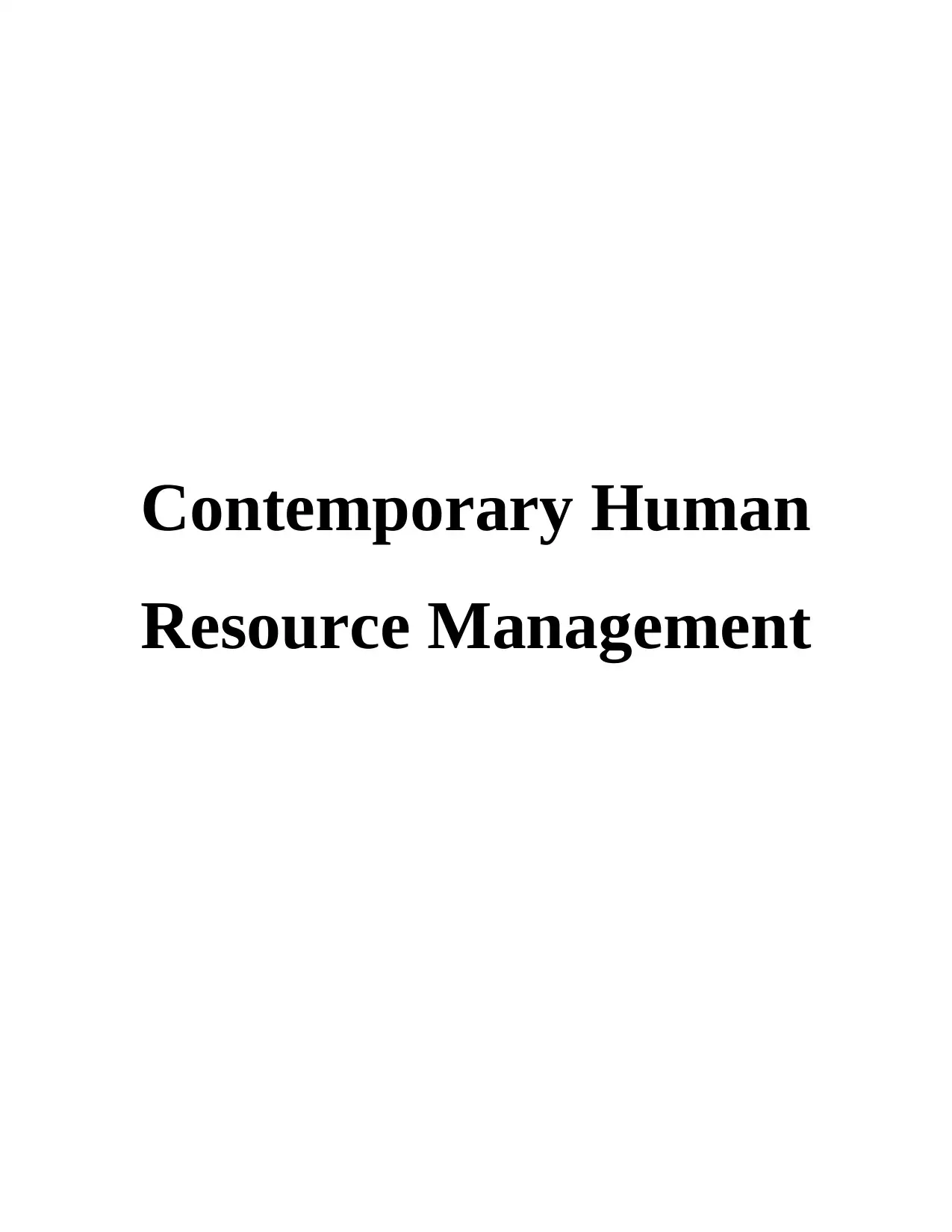
Contemporary Human
Resource Management
Resource Management
Paraphrase This Document
Need a fresh take? Get an instant paraphrase of this document with our AI Paraphraser
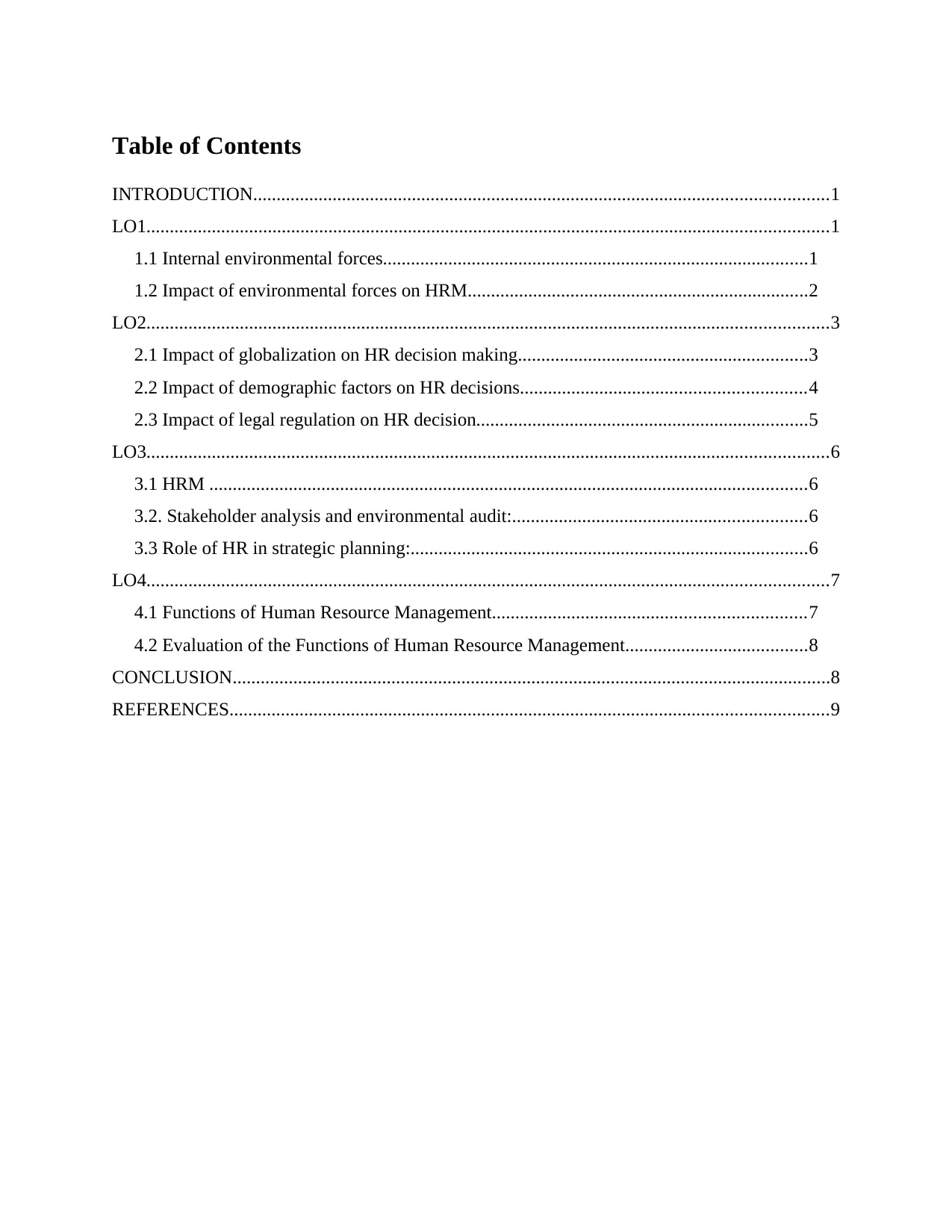
Table of Contents
INTRODUCTION...........................................................................................................................1
LO1..................................................................................................................................................1
1.1 Internal environmental forces...........................................................................................1
1.2 Impact of environmental forces on HRM.........................................................................2
LO2..................................................................................................................................................3
2.1 Impact of globalization on HR decision making..............................................................3
2.2 Impact of demographic factors on HR decisions.............................................................4
2.3 Impact of legal regulation on HR decision.......................................................................5
LO3..................................................................................................................................................6
3.1 HRM ................................................................................................................................6
3.2. Stakeholder analysis and environmental audit:...............................................................6
3.3 Role of HR in strategic planning:.....................................................................................6
LO4..................................................................................................................................................7
4.1 Functions of Human Resource Management...................................................................7
4.2 Evaluation of the Functions of Human Resource Management.......................................8
CONCLUSION................................................................................................................................8
REFERENCES................................................................................................................................9
INTRODUCTION...........................................................................................................................1
LO1..................................................................................................................................................1
1.1 Internal environmental forces...........................................................................................1
1.2 Impact of environmental forces on HRM.........................................................................2
LO2..................................................................................................................................................3
2.1 Impact of globalization on HR decision making..............................................................3
2.2 Impact of demographic factors on HR decisions.............................................................4
2.3 Impact of legal regulation on HR decision.......................................................................5
LO3..................................................................................................................................................6
3.1 HRM ................................................................................................................................6
3.2. Stakeholder analysis and environmental audit:...............................................................6
3.3 Role of HR in strategic planning:.....................................................................................6
LO4..................................................................................................................................................7
4.1 Functions of Human Resource Management...................................................................7
4.2 Evaluation of the Functions of Human Resource Management.......................................8
CONCLUSION................................................................................................................................8
REFERENCES................................................................................................................................9
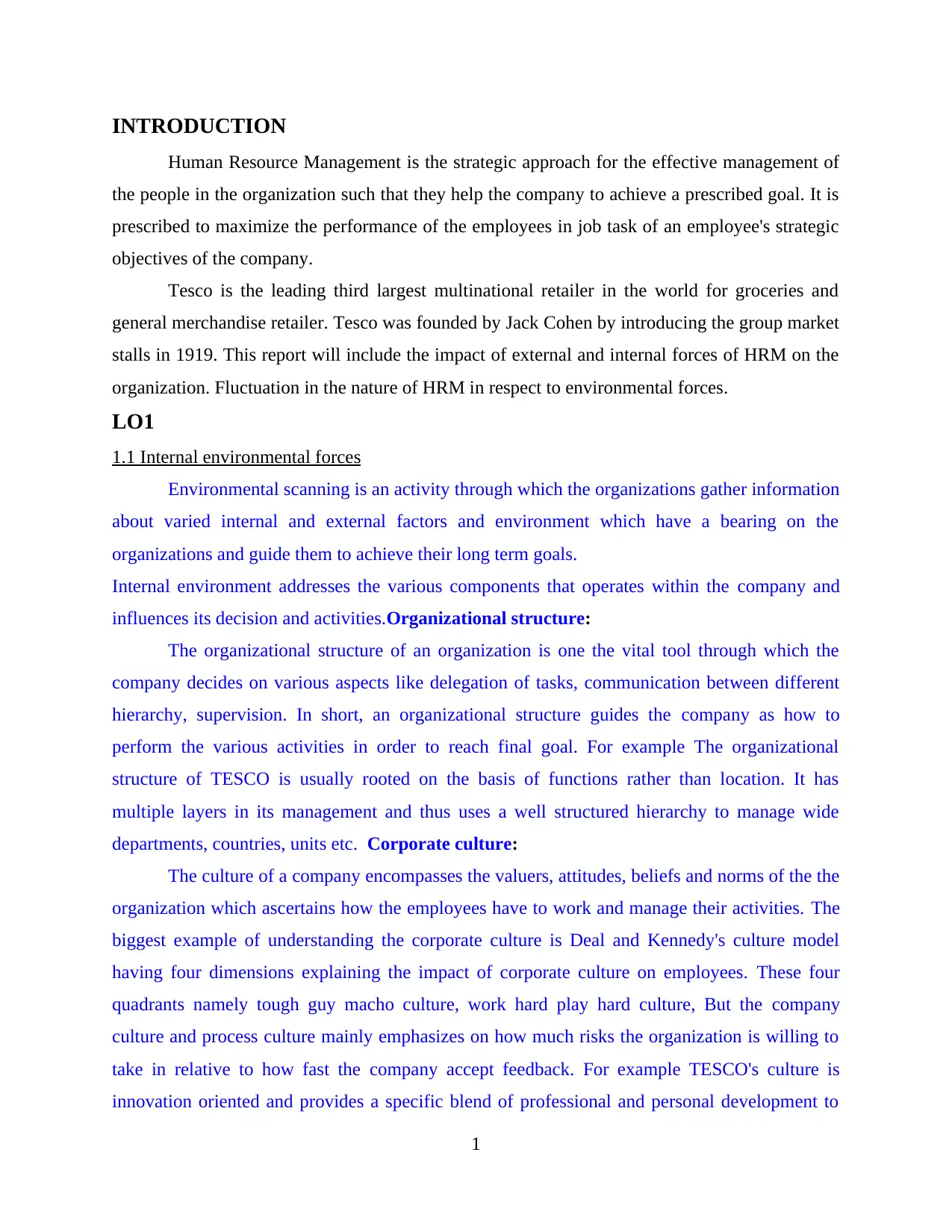
INTRODUCTION
Human Resource Management is the strategic approach for the effective management of
the people in the organization such that they help the company to achieve a prescribed goal. It is
prescribed to maximize the performance of the employees in job task of an employee's strategic
objectives of the company.
Tesco is the leading third largest multinational retailer in the world for groceries and
general merchandise retailer. Tesco was founded by Jack Cohen by introducing the group market
stalls in 1919. This report will include the impact of external and internal forces of HRM on the
organization. Fluctuation in the nature of HRM in respect to environmental forces.
LO1
1.1 Internal environmental forces
Environmental scanning is an activity through which the organizations gather information
about varied internal and external factors and environment which have a bearing on the
organizations and guide them to achieve their long term goals.
Internal environment addresses the various components that operates within the company and
influences its decision and activities.Organizational structure:
The organizational structure of an organization is one the vital tool through which the
company decides on various aspects like delegation of tasks, communication between different
hierarchy, supervision. In short, an organizational structure guides the company as how to
perform the various activities in order to reach final goal. For example The organizational
structure of TESCO is usually rooted on the basis of functions rather than location. It has
multiple layers in its management and thus uses a well structured hierarchy to manage wide
departments, countries, units etc. Corporate culture:
The culture of a company encompasses the valuers, attitudes, beliefs and norms of the the
organization which ascertains how the employees have to work and manage their activities. The
biggest example of understanding the corporate culture is Deal and Kennedy's culture model
having four dimensions explaining the impact of corporate culture on employees. These four
quadrants namely tough guy macho culture, work hard play hard culture, But the company
culture and process culture mainly emphasizes on how much risks the organization is willing to
take in relative to how fast the company accept feedback. For example TESCO's culture is
innovation oriented and provides a specific blend of professional and personal development to
1
Human Resource Management is the strategic approach for the effective management of
the people in the organization such that they help the company to achieve a prescribed goal. It is
prescribed to maximize the performance of the employees in job task of an employee's strategic
objectives of the company.
Tesco is the leading third largest multinational retailer in the world for groceries and
general merchandise retailer. Tesco was founded by Jack Cohen by introducing the group market
stalls in 1919. This report will include the impact of external and internal forces of HRM on the
organization. Fluctuation in the nature of HRM in respect to environmental forces.
LO1
1.1 Internal environmental forces
Environmental scanning is an activity through which the organizations gather information
about varied internal and external factors and environment which have a bearing on the
organizations and guide them to achieve their long term goals.
Internal environment addresses the various components that operates within the company and
influences its decision and activities.Organizational structure:
The organizational structure of an organization is one the vital tool through which the
company decides on various aspects like delegation of tasks, communication between different
hierarchy, supervision. In short, an organizational structure guides the company as how to
perform the various activities in order to reach final goal. For example The organizational
structure of TESCO is usually rooted on the basis of functions rather than location. It has
multiple layers in its management and thus uses a well structured hierarchy to manage wide
departments, countries, units etc. Corporate culture:
The culture of a company encompasses the valuers, attitudes, beliefs and norms of the the
organization which ascertains how the employees have to work and manage their activities. The
biggest example of understanding the corporate culture is Deal and Kennedy's culture model
having four dimensions explaining the impact of corporate culture on employees. These four
quadrants namely tough guy macho culture, work hard play hard culture, But the company
culture and process culture mainly emphasizes on how much risks the organization is willing to
take in relative to how fast the company accept feedback. For example TESCO's culture is
innovation oriented and provides a specific blend of professional and personal development to
1
⊘ This is a preview!⊘
Do you want full access?
Subscribe today to unlock all pages.

Trusted by 1+ million students worldwide

their employees thus having a strict commitment to serve their clients with high quality products.
In view of the above model, TESCO adopts different quadrant based on the scenario.(O'Donohue
and Torugsa, 2016).1.2 Impact of environmental forces on HRM
Workforce diversity
The workforce diversity is attributed to the change beliefs of an individuals towards other
employees in terms of age, sex, values, norms etc. With the increasing role of women at
workforce, Functions of HRM has taken a drastic turn. Their entry at the workplace has forced
the organizations to alter their policies and procedures like flexible working timings, maternity
facilities etc. For example TESCO emphasized on enhancing the female representation globally
and made various external commitments like including the females in finance charter.
Technological changes
Over the years, major technological changes have modified the occupational pattern. In
the era of globalization and liberalization, organizations are now striving to incorporate
technology in each and every aspect of their business and uplifting the socioeconomic concerns.
Digital technology ha splayed a remarkable role in making the organization competitive enough
and tech savvy. TESCO launched its own tablet and computer featuring its own high tech
services as three quarter households of UK were without tablet.Fombrun model
This model focuses on four key-points to make a company more effective key-points are
selection, development, appraisal and rewards
selection procedure of the company is based on the nature of firm if a worker is capable to
sustain himself in the work culture of the organization will they sustain in work pressure. By the
training workers are made familiar with work culture and the procedures which a company
follow to achieve the targets this improves the efficiency and skills of the workers human
resource development team work on all round development of the worker which bring appraisal
for the firm and brings improves stability of the firm in the market. By providing training to the
workers they are polished with extra skills which helps them to grow with the work and work
more efficiently. Workers which gives a quality result to the firm are rewarded with incentives
and bonuses. Which more or less boosts the working enthusiasm of the of workers and fellow
workers. This helps Tesco to improve with their quality and work ethics of the organization.LO2
2
In view of the above model, TESCO adopts different quadrant based on the scenario.(O'Donohue
and Torugsa, 2016).1.2 Impact of environmental forces on HRM
Workforce diversity
The workforce diversity is attributed to the change beliefs of an individuals towards other
employees in terms of age, sex, values, norms etc. With the increasing role of women at
workforce, Functions of HRM has taken a drastic turn. Their entry at the workplace has forced
the organizations to alter their policies and procedures like flexible working timings, maternity
facilities etc. For example TESCO emphasized on enhancing the female representation globally
and made various external commitments like including the females in finance charter.
Technological changes
Over the years, major technological changes have modified the occupational pattern. In
the era of globalization and liberalization, organizations are now striving to incorporate
technology in each and every aspect of their business and uplifting the socioeconomic concerns.
Digital technology ha splayed a remarkable role in making the organization competitive enough
and tech savvy. TESCO launched its own tablet and computer featuring its own high tech
services as three quarter households of UK were without tablet.Fombrun model
This model focuses on four key-points to make a company more effective key-points are
selection, development, appraisal and rewards
selection procedure of the company is based on the nature of firm if a worker is capable to
sustain himself in the work culture of the organization will they sustain in work pressure. By the
training workers are made familiar with work culture and the procedures which a company
follow to achieve the targets this improves the efficiency and skills of the workers human
resource development team work on all round development of the worker which bring appraisal
for the firm and brings improves stability of the firm in the market. By providing training to the
workers they are polished with extra skills which helps them to grow with the work and work
more efficiently. Workers which gives a quality result to the firm are rewarded with incentives
and bonuses. Which more or less boosts the working enthusiasm of the of workers and fellow
workers. This helps Tesco to improve with their quality and work ethics of the organization.LO2
2
Paraphrase This Document
Need a fresh take? Get an instant paraphrase of this document with our AI Paraphraser
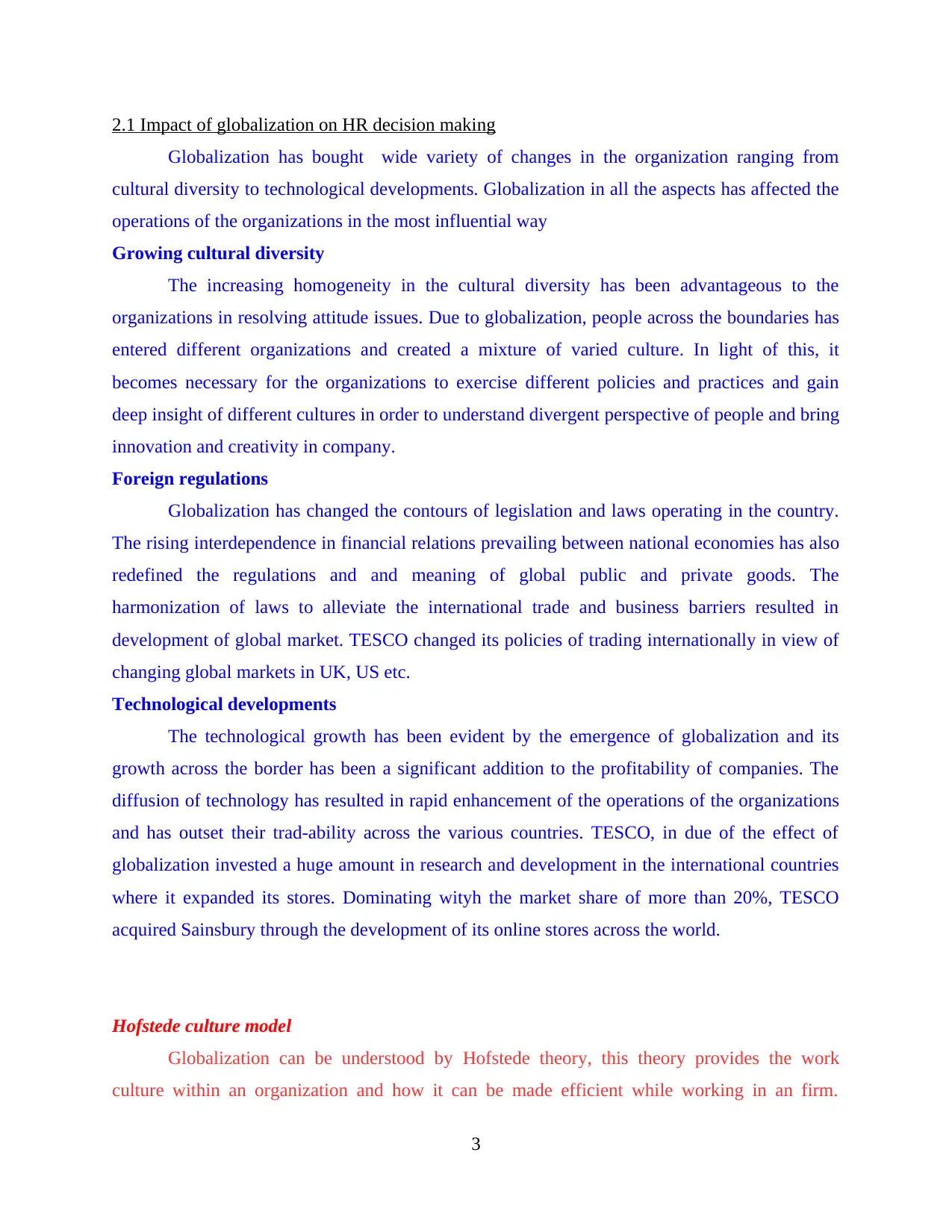
2.1 Impact of globalization on HR decision making
Globalization has bought wide variety of changes in the organization ranging from
cultural diversity to technological developments. Globalization in all the aspects has affected the
operations of the organizations in the most influential way
Growing cultural diversity
The increasing homogeneity in the cultural diversity has been advantageous to the
organizations in resolving attitude issues. Due to globalization, people across the boundaries has
entered different organizations and created a mixture of varied culture. In light of this, it
becomes necessary for the organizations to exercise different policies and practices and gain
deep insight of different cultures in order to understand divergent perspective of people and bring
innovation and creativity in company.
Foreign regulations
Globalization has changed the contours of legislation and laws operating in the country.
The rising interdependence in financial relations prevailing between national economies has also
redefined the regulations and and meaning of global public and private goods. The
harmonization of laws to alleviate the international trade and business barriers resulted in
development of global market. TESCO changed its policies of trading internationally in view of
changing global markets in UK, US etc.
Technological developments
The technological growth has been evident by the emergence of globalization and its
growth across the border has been a significant addition to the profitability of companies. The
diffusion of technology has resulted in rapid enhancement of the operations of the organizations
and has outset their trad-ability across the various countries. TESCO, in due of the effect of
globalization invested a huge amount in research and development in the international countries
where it expanded its stores. Dominating wityh the market share of more than 20%, TESCO
acquired Sainsbury through the development of its online stores across the world.
Hofstede culture model
Globalization can be understood by Hofstede theory, this theory provides the work
culture within an organization and how it can be made efficient while working in an firm.
3
Globalization has bought wide variety of changes in the organization ranging from
cultural diversity to technological developments. Globalization in all the aspects has affected the
operations of the organizations in the most influential way
Growing cultural diversity
The increasing homogeneity in the cultural diversity has been advantageous to the
organizations in resolving attitude issues. Due to globalization, people across the boundaries has
entered different organizations and created a mixture of varied culture. In light of this, it
becomes necessary for the organizations to exercise different policies and practices and gain
deep insight of different cultures in order to understand divergent perspective of people and bring
innovation and creativity in company.
Foreign regulations
Globalization has changed the contours of legislation and laws operating in the country.
The rising interdependence in financial relations prevailing between national economies has also
redefined the regulations and and meaning of global public and private goods. The
harmonization of laws to alleviate the international trade and business barriers resulted in
development of global market. TESCO changed its policies of trading internationally in view of
changing global markets in UK, US etc.
Technological developments
The technological growth has been evident by the emergence of globalization and its
growth across the border has been a significant addition to the profitability of companies. The
diffusion of technology has resulted in rapid enhancement of the operations of the organizations
and has outset their trad-ability across the various countries. TESCO, in due of the effect of
globalization invested a huge amount in research and development in the international countries
where it expanded its stores. Dominating wityh the market share of more than 20%, TESCO
acquired Sainsbury through the development of its online stores across the world.
Hofstede culture model
Globalization can be understood by Hofstede theory, this theory provides the work
culture within an organization and how it can be made efficient while working in an firm.
3
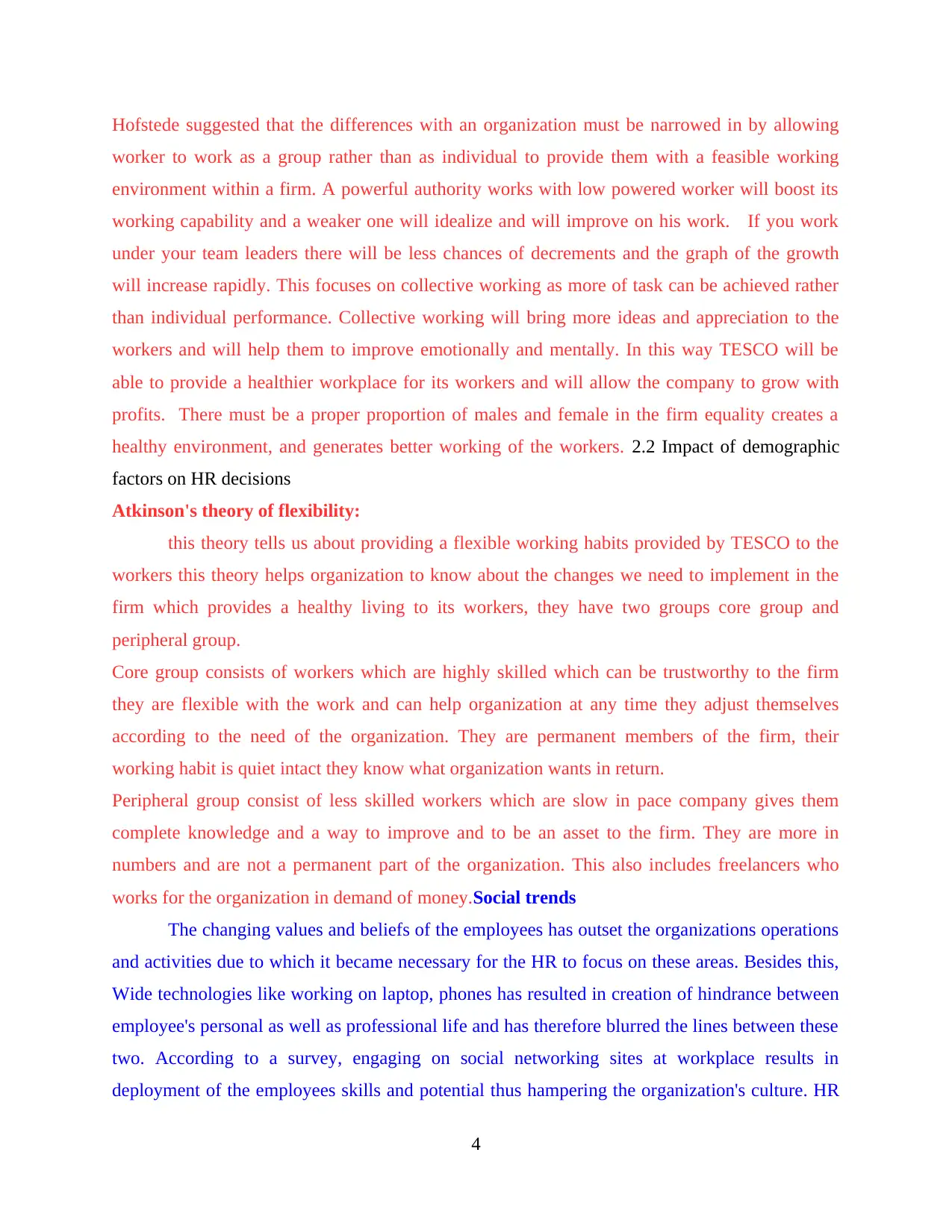
Hofstede suggested that the differences with an organization must be narrowed in by allowing
worker to work as a group rather than as individual to provide them with a feasible working
environment within a firm. A powerful authority works with low powered worker will boost its
working capability and a weaker one will idealize and will improve on his work. If you work
under your team leaders there will be less chances of decrements and the graph of the growth
will increase rapidly. This focuses on collective working as more of task can be achieved rather
than individual performance. Collective working will bring more ideas and appreciation to the
workers and will help them to improve emotionally and mentally. In this way TESCO will be
able to provide a healthier workplace for its workers and will allow the company to grow with
profits. There must be a proper proportion of males and female in the firm equality creates a
healthy environment, and generates better working of the workers. 2.2 Impact of demographic
factors on HR decisions
Atkinson's theory of flexibility:
this theory tells us about providing a flexible working habits provided by TESCO to the
workers this theory helps organization to know about the changes we need to implement in the
firm which provides a healthy living to its workers, they have two groups core group and
peripheral group.
Core group consists of workers which are highly skilled which can be trustworthy to the firm
they are flexible with the work and can help organization at any time they adjust themselves
according to the need of the organization. They are permanent members of the firm, their
working habit is quiet intact they know what organization wants in return.
Peripheral group consist of less skilled workers which are slow in pace company gives them
complete knowledge and a way to improve and to be an asset to the firm. They are more in
numbers and are not a permanent part of the organization. This also includes freelancers who
works for the organization in demand of money.Social trends
The changing values and beliefs of the employees has outset the organizations operations
and activities due to which it became necessary for the HR to focus on these areas. Besides this,
Wide technologies like working on laptop, phones has resulted in creation of hindrance between
employee's personal as well as professional life and has therefore blurred the lines between these
two. According to a survey, engaging on social networking sites at workplace results in
deployment of the employees skills and potential thus hampering the organization's culture. HR
4
worker to work as a group rather than as individual to provide them with a feasible working
environment within a firm. A powerful authority works with low powered worker will boost its
working capability and a weaker one will idealize and will improve on his work. If you work
under your team leaders there will be less chances of decrements and the graph of the growth
will increase rapidly. This focuses on collective working as more of task can be achieved rather
than individual performance. Collective working will bring more ideas and appreciation to the
workers and will help them to improve emotionally and mentally. In this way TESCO will be
able to provide a healthier workplace for its workers and will allow the company to grow with
profits. There must be a proper proportion of males and female in the firm equality creates a
healthy environment, and generates better working of the workers. 2.2 Impact of demographic
factors on HR decisions
Atkinson's theory of flexibility:
this theory tells us about providing a flexible working habits provided by TESCO to the
workers this theory helps organization to know about the changes we need to implement in the
firm which provides a healthy living to its workers, they have two groups core group and
peripheral group.
Core group consists of workers which are highly skilled which can be trustworthy to the firm
they are flexible with the work and can help organization at any time they adjust themselves
according to the need of the organization. They are permanent members of the firm, their
working habit is quiet intact they know what organization wants in return.
Peripheral group consist of less skilled workers which are slow in pace company gives them
complete knowledge and a way to improve and to be an asset to the firm. They are more in
numbers and are not a permanent part of the organization. This also includes freelancers who
works for the organization in demand of money.Social trends
The changing values and beliefs of the employees has outset the organizations operations
and activities due to which it became necessary for the HR to focus on these areas. Besides this,
Wide technologies like working on laptop, phones has resulted in creation of hindrance between
employee's personal as well as professional life and has therefore blurred the lines between these
two. According to a survey, engaging on social networking sites at workplace results in
deployment of the employees skills and potential thus hampering the organization's culture. HR
4
⊘ This is a preview!⊘
Do you want full access?
Subscribe today to unlock all pages.

Trusted by 1+ million students worldwide

are now focusing designing the strategies to enhance the quality of employee's life to circumvent
burnout. The HR department of TESCO is highly concerned regarding this and developed the
policies wherein the employees are not allowed to check after hour messages and mails.
Technological trends
Digital technology has always patronize Organizations and their strategies and has
redefined the functions of human resource. HR leaders utilizes data analysis to understand the
communication between them and employees. Technological advancement has broken the
monotonous nature of working of hr department and understand the employee's behaviour with
the help of digital information. The HR of TESCO through the use of automated solution and
cloud based apps, define their role in organization as well as manage the various activities like
compensation, payroll etc.2.3 Impact of legal regulation on HR decision1.Anti-discrimination
act(1975)
This act focusses on protecting the men and women & their rights and forbidding any
discrimination with respect to religion, caste, colour, sex, race. TESCO is highly motivated
towards anti discriminatory practices and does not entertain any illegal behaviour. Besides this,
The Policies of TESCO restricts
its managers to hurt or distress an employee to report against this act. There must not be any
discrimination in the organization and if this happens necessary actions must be taken. Which
may also lead to criminal offence. 2. Payment of wages act (1936)
According to this act, the immediate manager or employer of the employee is held
accountable for the correct and timely distribution of the fixed wages and the wages earned with
respect to the overtime. The HR managers in TESCO are responsible for specifying a wage
period for employees. They are enforced to pay the wages within this period which shall not
outrun more than one month. It is the responsibility of every employer to distribute the
additional emoluments called bonus to the workmen. A proper payroll must be delivered on time
as many of the workers are dependent on payrolls for the livelihood. HR must focus on the
payroll of the workers, a special loan facility must be provided to the workers. They must
provide educational support to the workers family. LO3
3.1 HRM
HRM refers to the strategic approach to the management of an organization which helps
in the advancement of an organization to give competitive advantage in the market. It states
5
burnout. The HR department of TESCO is highly concerned regarding this and developed the
policies wherein the employees are not allowed to check after hour messages and mails.
Technological trends
Digital technology has always patronize Organizations and their strategies and has
redefined the functions of human resource. HR leaders utilizes data analysis to understand the
communication between them and employees. Technological advancement has broken the
monotonous nature of working of hr department and understand the employee's behaviour with
the help of digital information. The HR of TESCO through the use of automated solution and
cloud based apps, define their role in organization as well as manage the various activities like
compensation, payroll etc.2.3 Impact of legal regulation on HR decision1.Anti-discrimination
act(1975)
This act focusses on protecting the men and women & their rights and forbidding any
discrimination with respect to religion, caste, colour, sex, race. TESCO is highly motivated
towards anti discriminatory practices and does not entertain any illegal behaviour. Besides this,
The Policies of TESCO restricts
its managers to hurt or distress an employee to report against this act. There must not be any
discrimination in the organization and if this happens necessary actions must be taken. Which
may also lead to criminal offence. 2. Payment of wages act (1936)
According to this act, the immediate manager or employer of the employee is held
accountable for the correct and timely distribution of the fixed wages and the wages earned with
respect to the overtime. The HR managers in TESCO are responsible for specifying a wage
period for employees. They are enforced to pay the wages within this period which shall not
outrun more than one month. It is the responsibility of every employer to distribute the
additional emoluments called bonus to the workmen. A proper payroll must be delivered on time
as many of the workers are dependent on payrolls for the livelihood. HR must focus on the
payroll of the workers, a special loan facility must be provided to the workers. They must
provide educational support to the workers family. LO3
3.1 HRM
HRM refers to the strategic approach to the management of an organization which helps
in the advancement of an organization to give competitive advantage in the market. It states
5
Paraphrase This Document
Need a fresh take? Get an instant paraphrase of this document with our AI Paraphraser
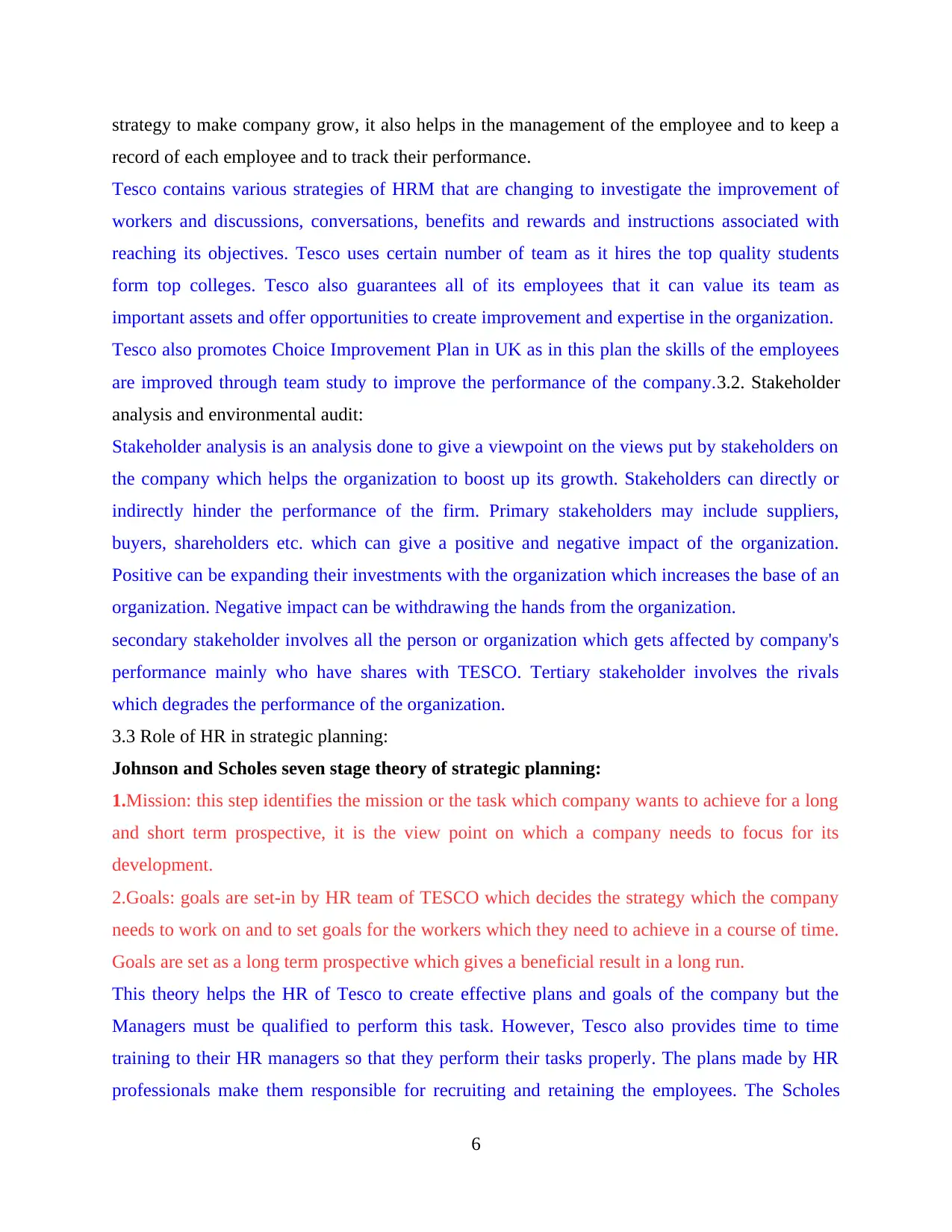
strategy to make company grow, it also helps in the management of the employee and to keep a
record of each employee and to track their performance.
Tesco contains various strategies of HRM that are changing to investigate the improvement of
workers and discussions, conversations, benefits and rewards and instructions associated with
reaching its objectives. Tesco uses certain number of team as it hires the top quality students
form top colleges. Tesco also guarantees all of its employees that it can value its team as
important assets and offer opportunities to create improvement and expertise in the organization.
Tesco also promotes Choice Improvement Plan in UK as in this plan the skills of the employees
are improved through team study to improve the performance of the company.3.2. Stakeholder
analysis and environmental audit:
Stakeholder analysis is an analysis done to give a viewpoint on the views put by stakeholders on
the company which helps the organization to boost up its growth. Stakeholders can directly or
indirectly hinder the performance of the firm. Primary stakeholders may include suppliers,
buyers, shareholders etc. which can give a positive and negative impact of the organization.
Positive can be expanding their investments with the organization which increases the base of an
organization. Negative impact can be withdrawing the hands from the organization.
secondary stakeholder involves all the person or organization which gets affected by company's
performance mainly who have shares with TESCO. Tertiary stakeholder involves the rivals
which degrades the performance of the organization.
3.3 Role of HR in strategic planning:
Johnson and Scholes seven stage theory of strategic planning:
1.Mission: this step identifies the mission or the task which company wants to achieve for a long
and short term prospective, it is the view point on which a company needs to focus for its
development.
2.Goals: goals are set-in by HR team of TESCO which decides the strategy which the company
needs to work on and to set goals for the workers which they need to achieve in a course of time.
Goals are set as a long term prospective which gives a beneficial result in a long run.
This theory helps the HR of Tesco to create effective plans and goals of the company but the
Managers must be qualified to perform this task. However, Tesco also provides time to time
training to their HR managers so that they perform their tasks properly. The plans made by HR
professionals make them responsible for recruiting and retaining the employees. The Scholes
6
record of each employee and to track their performance.
Tesco contains various strategies of HRM that are changing to investigate the improvement of
workers and discussions, conversations, benefits and rewards and instructions associated with
reaching its objectives. Tesco uses certain number of team as it hires the top quality students
form top colleges. Tesco also guarantees all of its employees that it can value its team as
important assets and offer opportunities to create improvement and expertise in the organization.
Tesco also promotes Choice Improvement Plan in UK as in this plan the skills of the employees
are improved through team study to improve the performance of the company.3.2. Stakeholder
analysis and environmental audit:
Stakeholder analysis is an analysis done to give a viewpoint on the views put by stakeholders on
the company which helps the organization to boost up its growth. Stakeholders can directly or
indirectly hinder the performance of the firm. Primary stakeholders may include suppliers,
buyers, shareholders etc. which can give a positive and negative impact of the organization.
Positive can be expanding their investments with the organization which increases the base of an
organization. Negative impact can be withdrawing the hands from the organization.
secondary stakeholder involves all the person or organization which gets affected by company's
performance mainly who have shares with TESCO. Tertiary stakeholder involves the rivals
which degrades the performance of the organization.
3.3 Role of HR in strategic planning:
Johnson and Scholes seven stage theory of strategic planning:
1.Mission: this step identifies the mission or the task which company wants to achieve for a long
and short term prospective, it is the view point on which a company needs to focus for its
development.
2.Goals: goals are set-in by HR team of TESCO which decides the strategy which the company
needs to work on and to set goals for the workers which they need to achieve in a course of time.
Goals are set as a long term prospective which gives a beneficial result in a long run.
This theory helps the HR of Tesco to create effective plans and goals of the company but the
Managers must be qualified to perform this task. However, Tesco also provides time to time
training to their HR managers so that they perform their tasks properly. The plans made by HR
professionals make them responsible for recruiting and retaining the employees. The Scholes
6
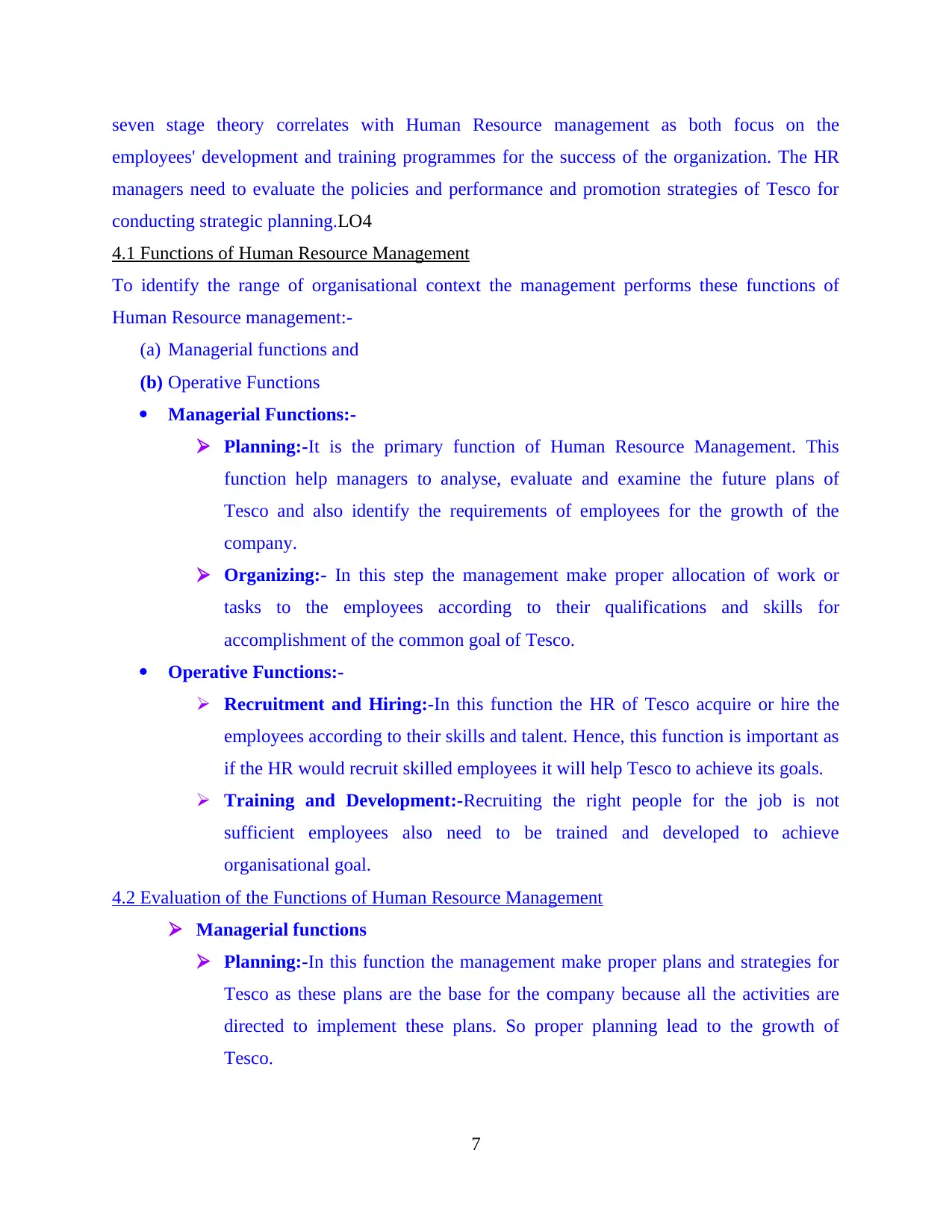
seven stage theory correlates with Human Resource management as both focus on the
employees' development and training programmes for the success of the organization. The HR
managers need to evaluate the policies and performance and promotion strategies of Tesco for
conducting strategic planning.LO4
4.1 Functions of Human Resource Management
To identify the range of organisational context the management performs these functions of
Human Resource management:-
(a) Managerial functions and
(b) Operative Functions
Managerial Functions:-
Planning:-It is the primary function of Human Resource Management. This
function help managers to analyse, evaluate and examine the future plans of
Tesco and also identify the requirements of employees for the growth of the
company.
Organizing:- In this step the management make proper allocation of work or
tasks to the employees according to their qualifications and skills for
accomplishment of the common goal of Tesco.
Operative Functions:-
Recruitment and Hiring:-In this function the HR of Tesco acquire or hire the
employees according to their skills and talent. Hence, this function is important as
if the HR would recruit skilled employees it will help Tesco to achieve its goals.
Training and Development:-Recruiting the right people for the job is not
sufficient employees also need to be trained and developed to achieve
organisational goal.
4.2 Evaluation of the Functions of Human Resource Management
Managerial functions
Planning:-In this function the management make proper plans and strategies for
Tesco as these plans are the base for the company because all the activities are
directed to implement these plans. So proper planning lead to the growth of
Tesco.
7
employees' development and training programmes for the success of the organization. The HR
managers need to evaluate the policies and performance and promotion strategies of Tesco for
conducting strategic planning.LO4
4.1 Functions of Human Resource Management
To identify the range of organisational context the management performs these functions of
Human Resource management:-
(a) Managerial functions and
(b) Operative Functions
Managerial Functions:-
Planning:-It is the primary function of Human Resource Management. This
function help managers to analyse, evaluate and examine the future plans of
Tesco and also identify the requirements of employees for the growth of the
company.
Organizing:- In this step the management make proper allocation of work or
tasks to the employees according to their qualifications and skills for
accomplishment of the common goal of Tesco.
Operative Functions:-
Recruitment and Hiring:-In this function the HR of Tesco acquire or hire the
employees according to their skills and talent. Hence, this function is important as
if the HR would recruit skilled employees it will help Tesco to achieve its goals.
Training and Development:-Recruiting the right people for the job is not
sufficient employees also need to be trained and developed to achieve
organisational goal.
4.2 Evaluation of the Functions of Human Resource Management
Managerial functions
Planning:-In this function the management make proper plans and strategies for
Tesco as these plans are the base for the company because all the activities are
directed to implement these plans. So proper planning lead to the growth of
Tesco.
7
⊘ This is a preview!⊘
Do you want full access?
Subscribe today to unlock all pages.

Trusted by 1+ million students worldwide
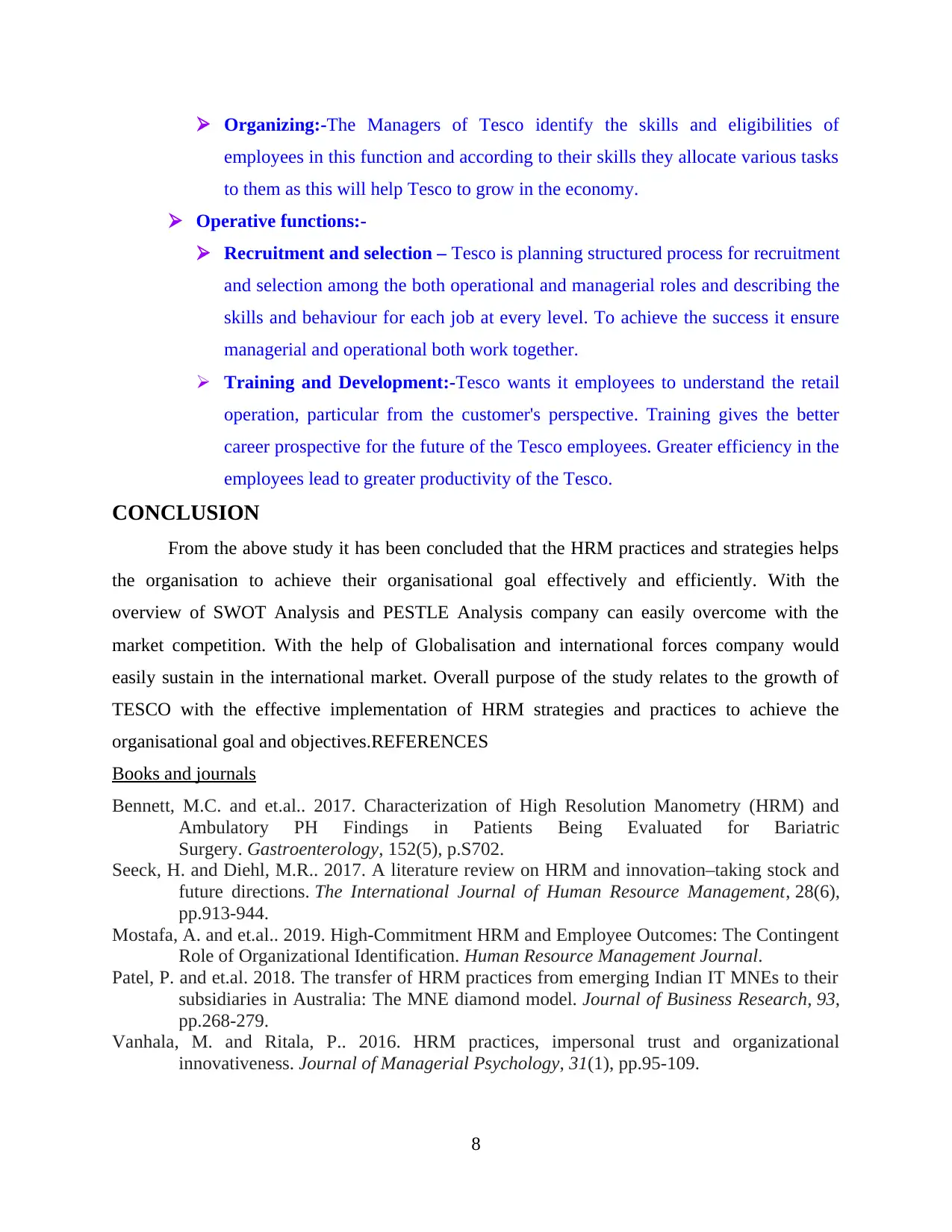
Organizing:-The Managers of Tesco identify the skills and eligibilities of
employees in this function and according to their skills they allocate various tasks
to them as this will help Tesco to grow in the economy.
Operative functions:-
Recruitment and selection – Tesco is planning structured process for recruitment
and selection among the both operational and managerial roles and describing the
skills and behaviour for each job at every level. To achieve the success it ensure
managerial and operational both work together.
Training and Development:-Tesco wants it employees to understand the retail
operation, particular from the customer's perspective. Training gives the better
career prospective for the future of the Tesco employees. Greater efficiency in the
employees lead to greater productivity of the Tesco.
CONCLUSION
From the above study it has been concluded that the HRM practices and strategies helps
the organisation to achieve their organisational goal effectively and efficiently. With the
overview of SWOT Analysis and PESTLE Analysis company can easily overcome with the
market competition. With the help of Globalisation and international forces company would
easily sustain in the international market. Overall purpose of the study relates to the growth of
TESCO with the effective implementation of HRM strategies and practices to achieve the
organisational goal and objectives.REFERENCES
Books and journals
Bennett, M.C. and et.al.. 2017. Characterization of High Resolution Manometry (HRM) and
Ambulatory PH Findings in Patients Being Evaluated for Bariatric
Surgery. Gastroenterology, 152(5), p.S702.
Seeck, H. and Diehl, M.R.. 2017. A literature review on HRM and innovation–taking stock and
future directions. The International Journal of Human Resource Management, 28(6),
pp.913-944.
Mostafa, A. and et.al.. 2019. High-Commitment HRM and Employee Outcomes: The Contingent
Role of Organizational Identification. Human Resource Management Journal.
Patel, P. and et.al. 2018. The transfer of HRM practices from emerging Indian IT MNEs to their
subsidiaries in Australia: The MNE diamond model. Journal of Business Research, 93,
pp.268-279.
Vanhala, M. and Ritala, P.. 2016. HRM practices, impersonal trust and organizational
innovativeness. Journal of Managerial Psychology, 31(1), pp.95-109.
8
employees in this function and according to their skills they allocate various tasks
to them as this will help Tesco to grow in the economy.
Operative functions:-
Recruitment and selection – Tesco is planning structured process for recruitment
and selection among the both operational and managerial roles and describing the
skills and behaviour for each job at every level. To achieve the success it ensure
managerial and operational both work together.
Training and Development:-Tesco wants it employees to understand the retail
operation, particular from the customer's perspective. Training gives the better
career prospective for the future of the Tesco employees. Greater efficiency in the
employees lead to greater productivity of the Tesco.
CONCLUSION
From the above study it has been concluded that the HRM practices and strategies helps
the organisation to achieve their organisational goal effectively and efficiently. With the
overview of SWOT Analysis and PESTLE Analysis company can easily overcome with the
market competition. With the help of Globalisation and international forces company would
easily sustain in the international market. Overall purpose of the study relates to the growth of
TESCO with the effective implementation of HRM strategies and practices to achieve the
organisational goal and objectives.REFERENCES
Books and journals
Bennett, M.C. and et.al.. 2017. Characterization of High Resolution Manometry (HRM) and
Ambulatory PH Findings in Patients Being Evaluated for Bariatric
Surgery. Gastroenterology, 152(5), p.S702.
Seeck, H. and Diehl, M.R.. 2017. A literature review on HRM and innovation–taking stock and
future directions. The International Journal of Human Resource Management, 28(6),
pp.913-944.
Mostafa, A. and et.al.. 2019. High-Commitment HRM and Employee Outcomes: The Contingent
Role of Organizational Identification. Human Resource Management Journal.
Patel, P. and et.al. 2018. The transfer of HRM practices from emerging Indian IT MNEs to their
subsidiaries in Australia: The MNE diamond model. Journal of Business Research, 93,
pp.268-279.
Vanhala, M. and Ritala, P.. 2016. HRM practices, impersonal trust and organizational
innovativeness. Journal of Managerial Psychology, 31(1), pp.95-109.
8
Paraphrase This Document
Need a fresh take? Get an instant paraphrase of this document with our AI Paraphraser
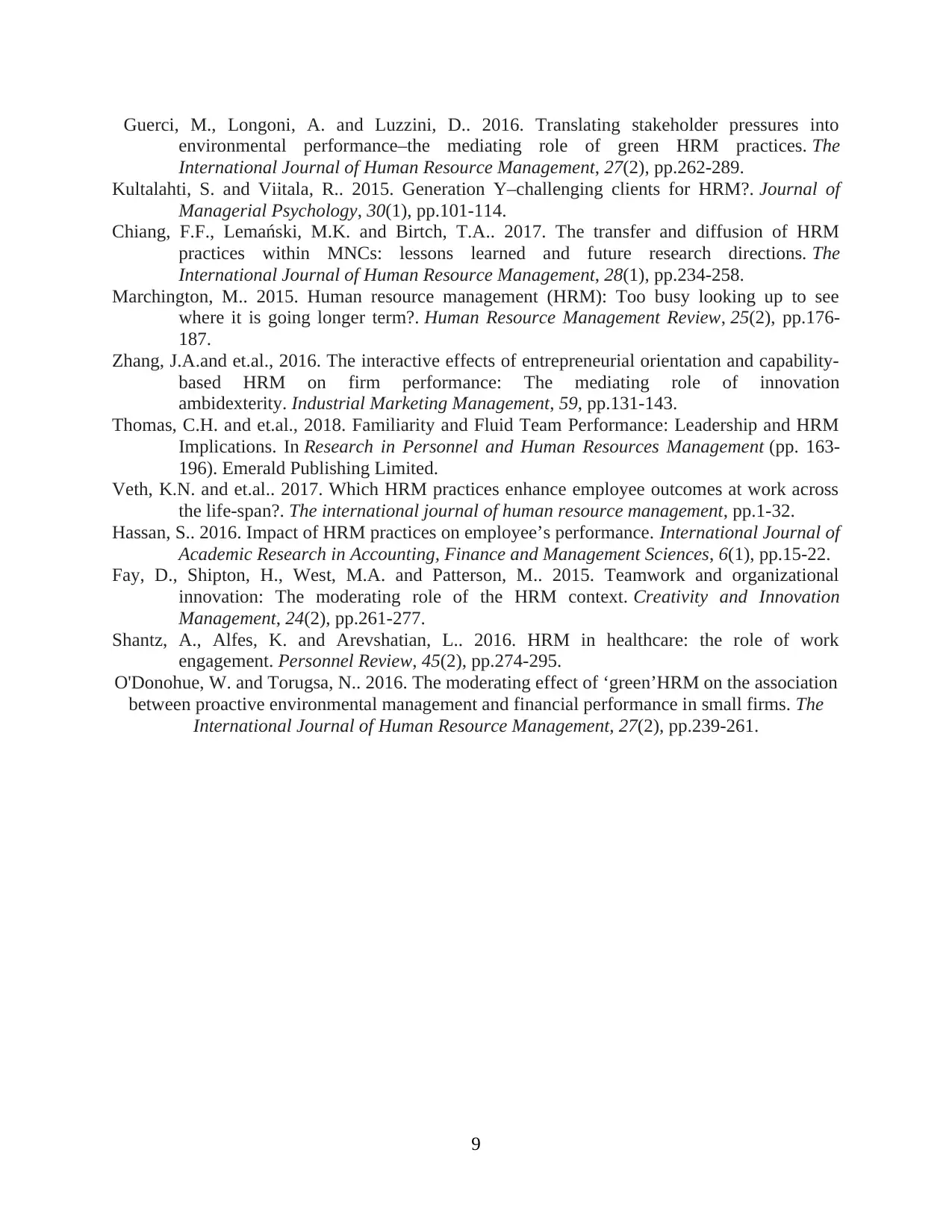
Guerci, M., Longoni, A. and Luzzini, D.. 2016. Translating stakeholder pressures into
environmental performance–the mediating role of green HRM practices. The
International Journal of Human Resource Management, 27(2), pp.262-289.
Kultalahti, S. and Viitala, R.. 2015. Generation Y–challenging clients for HRM?. Journal of
Managerial Psychology, 30(1), pp.101-114.
Chiang, F.F., Lemański, M.K. and Birtch, T.A.. 2017. The transfer and diffusion of HRM
practices within MNCs: lessons learned and future research directions. The
International Journal of Human Resource Management, 28(1), pp.234-258.
Marchington, M.. 2015. Human resource management (HRM): Too busy looking up to see
where it is going longer term?. Human Resource Management Review, 25(2), pp.176-
187.
Zhang, J.A.and et.al., 2016. The interactive effects of entrepreneurial orientation and capability-
based HRM on firm performance: The mediating role of innovation
ambidexterity. Industrial Marketing Management, 59, pp.131-143.
Thomas, C.H. and et.al., 2018. Familiarity and Fluid Team Performance: Leadership and HRM
Implications. In Research in Personnel and Human Resources Management (pp. 163-
196). Emerald Publishing Limited.
Veth, K.N. and et.al.. 2017. Which HRM practices enhance employee outcomes at work across
the life-span?. The international journal of human resource management, pp.1-32.
Hassan, S.. 2016. Impact of HRM practices on employee’s performance. International Journal of
Academic Research in Accounting, Finance and Management Sciences, 6(1), pp.15-22.
Fay, D., Shipton, H., West, M.A. and Patterson, M.. 2015. Teamwork and organizational
innovation: The moderating role of the HRM context. Creativity and Innovation
Management, 24(2), pp.261-277.
Shantz, A., Alfes, K. and Arevshatian, L.. 2016. HRM in healthcare: the role of work
engagement. Personnel Review, 45(2), pp.274-295.
O'Donohue, W. and Torugsa, N.. 2016. The moderating effect of ‘green’HRM on the association
between proactive environmental management and financial performance in small firms. The
International Journal of Human Resource Management, 27(2), pp.239-261.
9
environmental performance–the mediating role of green HRM practices. The
International Journal of Human Resource Management, 27(2), pp.262-289.
Kultalahti, S. and Viitala, R.. 2015. Generation Y–challenging clients for HRM?. Journal of
Managerial Psychology, 30(1), pp.101-114.
Chiang, F.F., Lemański, M.K. and Birtch, T.A.. 2017. The transfer and diffusion of HRM
practices within MNCs: lessons learned and future research directions. The
International Journal of Human Resource Management, 28(1), pp.234-258.
Marchington, M.. 2015. Human resource management (HRM): Too busy looking up to see
where it is going longer term?. Human Resource Management Review, 25(2), pp.176-
187.
Zhang, J.A.and et.al., 2016. The interactive effects of entrepreneurial orientation and capability-
based HRM on firm performance: The mediating role of innovation
ambidexterity. Industrial Marketing Management, 59, pp.131-143.
Thomas, C.H. and et.al., 2018. Familiarity and Fluid Team Performance: Leadership and HRM
Implications. In Research in Personnel and Human Resources Management (pp. 163-
196). Emerald Publishing Limited.
Veth, K.N. and et.al.. 2017. Which HRM practices enhance employee outcomes at work across
the life-span?. The international journal of human resource management, pp.1-32.
Hassan, S.. 2016. Impact of HRM practices on employee’s performance. International Journal of
Academic Research in Accounting, Finance and Management Sciences, 6(1), pp.15-22.
Fay, D., Shipton, H., West, M.A. and Patterson, M.. 2015. Teamwork and organizational
innovation: The moderating role of the HRM context. Creativity and Innovation
Management, 24(2), pp.261-277.
Shantz, A., Alfes, K. and Arevshatian, L.. 2016. HRM in healthcare: the role of work
engagement. Personnel Review, 45(2), pp.274-295.
O'Donohue, W. and Torugsa, N.. 2016. The moderating effect of ‘green’HRM on the association
between proactive environmental management and financial performance in small firms. The
International Journal of Human Resource Management, 27(2), pp.239-261.
9
1 out of 11
Related Documents
Your All-in-One AI-Powered Toolkit for Academic Success.
+13062052269
info@desklib.com
Available 24*7 on WhatsApp / Email
![[object Object]](/_next/static/media/star-bottom.7253800d.svg)
Unlock your academic potential
Copyright © 2020–2025 A2Z Services. All Rights Reserved. Developed and managed by ZUCOL.




